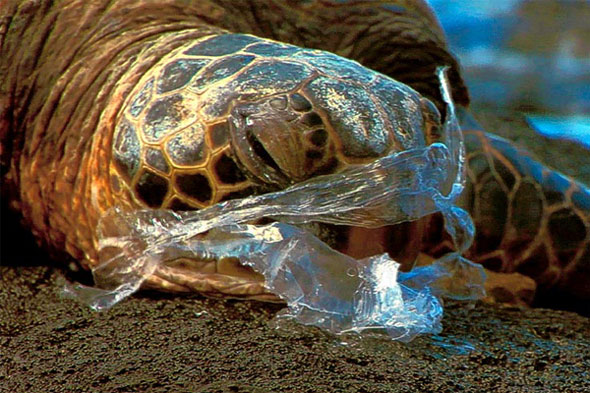Similar to the impacts that plastics have on coral reefs, every day marine animals suffer from the effects of plastic through various ways that harm their bodies. They usually either get entangled by plastics in the oceans or ingest the plastic pieces leading to illnesses. These harm caused to marine animals often result in their deaths. Plastic is killing more than 100,000 sea turtles and birds from ingestion and entanglement annually.
-
Suffocation

Animals like the seal above usually began from having their necks choked by plastic rings from a young age. As the animal grows larger, the plastic does not expand, hence they suffocate from the lack of breathing space as it is limited by the plastic tightening around their necks. Many in this state are often also unable to consume food, leading to starvation as well.
Starvation

“Ghost fishing” is a phenomenon where marine animals are get entangled in nets, lines, traps or other discarded fishing equipment. It is an unintentional act of trapping animals and entanglement in plastic can result in suffocation, starvation, as well as external injuries suffered by the marine animals. The animals find themselves stuck in the nets and unable to move around to feed, hence starvation is a critical issue caused by abandoned plastic nets floating around the ocean.
Injury
Warning: Coarse language used in video.
At times, plastic nets can also cause injury to the bodies of marine animals. For instance, when sharks get entangled in the nets, they would normally struggle and might result in its fins being torn during the struggle to free itself. In the case of the video shown below, plastic causes external physical injury to animals in the form of a common object that we use: plastic straws. The slightly gruesome sight of having a plastic straw being pulled out from a turtle’s nostril and its anguished expression should pain the viewers who watches it.
Ingestion

Ingestion of plastic can cause illnesses by toxins, loss of nutrition due to intestinal blockage and internal injuries by sharp edged plastics. Turtles are unable to differentiate a plastic bag floating in the ocean and a jellyfish because they look similar, hence often ingest them. Other marine animals consume the plastics together with their food because plastics will break down into smaller pieces that may also have sharp edges as shown in the image below. Marine animals may also ingest plastics indirectly as they feed on other animals that have already ingested plastics. In this way, the plastics travel up the food chain and are also consumed by larger animals (even humans). Larger animals or those who are higher up on the food chain in turn consumes more plastic as their preys may have ingested plastics from multiple sources.

Next, impacts on humans.
Previously, impacts on coral reefs.
Be First to Comment